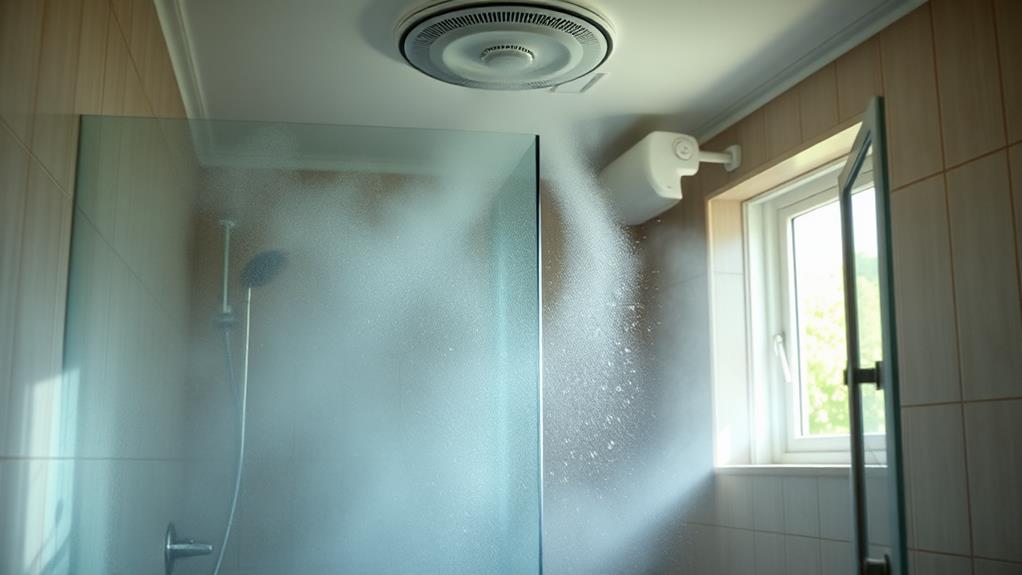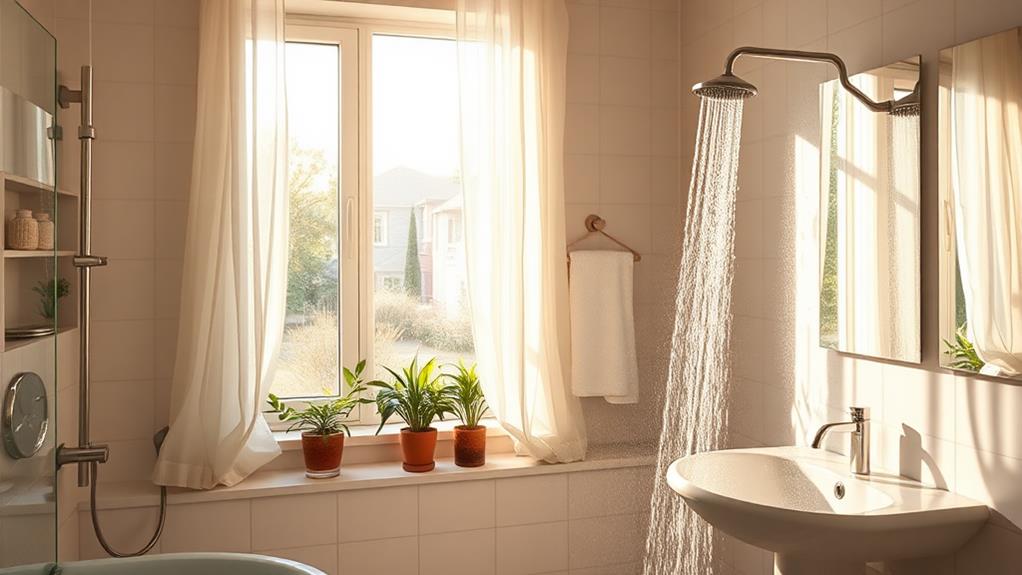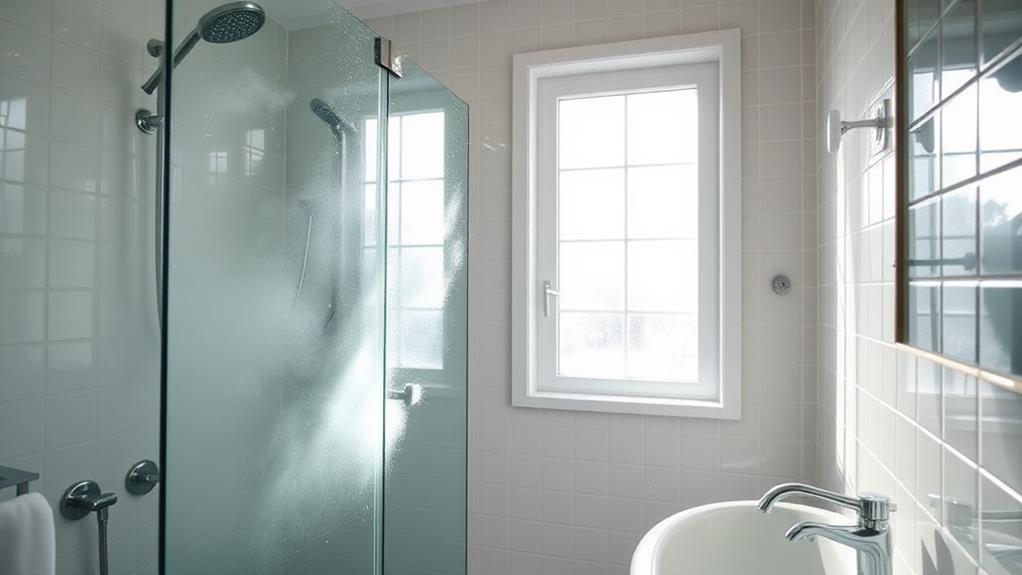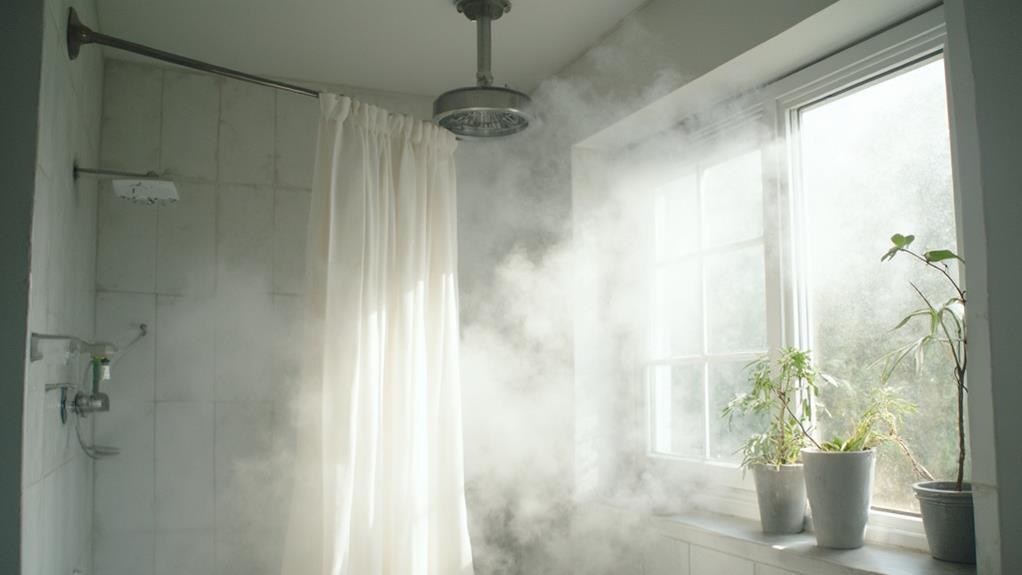Proper bathroom ventilation is crucial for maintaining a fresh, mold-free space. You'll need an exhaust fan that can move at least 1 CFM per square foot of bathroom area. Run it during and for 30 minutes after showers to remove excess moisture. Natural ventilation methods, like opening windows, can also help. Keep surfaces dry and fix leaks promptly to prevent mold growth. Clean your exhaust fan every six months and check ductwork annually for optimal performance. Using mold-resistant products and dehumidifiers can further protect your bathroom. By understanding these basics, you'll be well on your way to a healthier, more comfortable bathroom environment.
Understanding Bathroom Ventilation Basics

Proper bathroom ventilation is often overlooked but crucial for maintaining a healthy and comfortable home environment. It's essential for removing excess moisture, preventing mold growth, and eliminating odors. Bathroom ventilation typically involves two main components: exhaust fans and air circulation.
Exhaust fans are the primary means of ventilation in most bathrooms. They work by drawing out moist air and expelling it outdoors. When choosing an exhaust fan, consider its capacity, measured in cubic feet per minute (CFM). A general rule is to have at least 1 CFM per square foot of bathroom space. For example, a 50 square foot bathroom would require a fan with at least 50 CFM capacity.
Air circulation is equally important. It helps distribute fresh air throughout the bathroom and prevents stagnant pockets where moisture can accumulate. This can be achieved through proper placement of exhaust fans, strategically positioned windows, or even by leaving the bathroom door open when possible.
Remember that effective ventilation doesn't just mean running a fan during showers. Ideally, you should keep the fan running for at least 30 minutes after bathing to ensure thorough moisture removal.
Types of Ventilation Systems
For bathroom ventilation, you'll find several types of systems available, each with its own advantages. The most common is the ceiling-mounted exhaust fan, which efficiently removes moisture and odors. These fans come in various sizes and noise levels, suitable for different bathroom dimensions.
Wall-mounted exhaust fans are another option, ideal for bathrooms without attic access. They're installed directly through an exterior wall, making them easier to maintain. For a more discreet solution, consider inline fans. These are mounted in the attic or ceiling cavity, connected to the bathroom via ductwork, resulting in quieter operation.
If you're looking for a multifunctional option, consider combination units. These integrate exhaust fans with lighting, heating, or even Bluetooth speakers. For natural ventilation, operable windows can be effective, especially when paired with a ceiling fan to improve air circulation.
Heat recovery ventilators (HRVs) are energy-efficient systems that exchange stale air with fresh air while retaining heat. They're particularly useful in colder climates. Lastly, passive vents, like grilles or louvers, can supplement mechanical systems by allowing air to flow naturally between rooms or to the outdoors.
Effective Natural Ventilation Methods

While mechanical systems offer efficient solutions, natural ventilation methods can be equally effective in maintaining a fresh bathroom environment. The simplest method is to open a window regularly, especially after showers or baths. This allows moist air to escape and fresh air to circulate. If you're concerned about privacy, consider installing a high-level window or skylight that's easily accessible.
Another effective technique is creating cross-ventilation by opening two windows or a window and a door. This creates a natural airflow path, quickly removing stale air and moisture. If your bathroom lacks windows, you can still improve air circulation by keeping the door open when the room's not in use.
Strategically placed plants can also help purify the air naturally. Spider plants, peace lilies, and Boston ferns are excellent choices for bathrooms as they thrive in humid environments and absorb excess moisture. Additionally, using natural dehumidifying materials like silica gel packets or activated charcoal can help reduce moisture levels. Remember to empty and clean these regularly to maintain their effectiveness.
Dealing With Humidity Issues
Humidity, the silent enemy of bathrooms, can lead to mold growth and structural damage if left unchecked. To combat this issue, you'll need to implement effective strategies to manage moisture levels in your bathroom.
First, ensure your exhaust fan is running during showers and for at least 30 minutes afterward. This helps remove excess moisture from the air. If you don't have an exhaust fan, consider installing one as soon as possible.
Use a squeegee on shower walls and doors after each use to remove water droplets. This simple habit can significantly reduce humidity levels. Additionally, keep shower curtains open to allow air circulation and prevent mildew growth.
Invest in a dehumidifier if your bathroom struggles with persistent dampness. Place it in a central location and empty the water reservoir regularly. You can also use moisture-absorbing products like silica gel packets or activated charcoal to help reduce humidity.
Regularly check for leaks in pipes, faucets, and around the toilet base. Fix any issues promptly to prevent excess moisture from accumulating. Finally, consider using mold-resistant paint and grout in your bathroom to further protect against humidity-related problems.
Preventing Mold Growth

Despite your best efforts to control humidity, mold can still be a persistent threat in bathrooms. To prevent its growth, you'll need to implement a multi-faceted approach.
First, ensure your bathroom has proper ventilation. Run your exhaust fan during showers and for at least 30 minutes afterward. If you don't have a fan, open a window to promote air circulation.
Keep surfaces dry by wiping down shower walls, tubs, and sinks after use. Use a squeegee on glass shower doors to remove excess water. Regularly wash and dry bath mats, towels, and shower curtains to prevent moisture buildup. Pay special attention to grout lines and caulking, as these areas are prone to mold growth.
Use mold-resistant products when possible, such as shower curtains and paints designed for high-humidity areas. Consider applying a mold inhibitor to vulnerable surfaces. Fix any leaks promptly, as standing water is a breeding ground for mold.
Regularly inspect your bathroom for signs of mold, paying close attention to hidden areas like under sinks or behind toilets. If you spot mold, clean it immediately using appropriate cleaning products or seek professional help for extensive growth.
Maintenance and Troubleshooting Tips
Regular maintenance is key to keeping your bathroom ventilation system in top shape. Clean your exhaust fan every six months by removing the cover and wiping down the blades and housing with a damp cloth. Vacuum any dust buildup and ensure the vent flap moves freely.
Check your ductwork annually for leaks or disconnections. Seal any gaps with aluminum tape and reattach loose connections. If you notice reduced airflow, inspect the exterior vent cover for blockages like leaves or debris.
Listen for unusual noises when the fan runs, as this may indicate worn bearings or a loose impeller. Replace faulty parts promptly to prevent further damage. If your fan isn't turning on, check the circuit breaker and test the switch. You may need to replace a faulty switch or motor.
For humidity-sensing fans, clean the sensor regularly to maintain accuracy. If it's not activating properly, adjust the sensitivity settings or consider replacement if it's old.
Don't forget to replace your fan every 10-15 years, as efficiency decreases over time. By following these tips, you'll keep your bathroom well-ventilated and mold-free for years to come.
Conclusion
You might think proper bathroom ventilation is a hassle, but it's essential for your health and home. By implementing the right system and practices, you'll keep your bathroom fresh and mold-free. Don't neglect regular maintenance and be proactive about addressing humidity issues. Remember, a well-ventilated bathroom isn't just about comfort—it's about protecting your property and preventing potentially hazardous mold growth. Take action today to ensure your bathroom stays clean, dry, and inviting.

